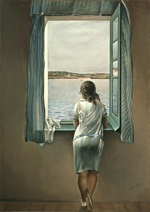
Family
"Though there was seventy years' difference in their ages, the spiritual
distance between them was slight" (526).
Flannery O'Connor's "A View of the Woods" (1956; 1957)
Points
for Reflection
EBB: "Bertha in the Lane" (1844), 156-66
- has the narrator fulfilled the promise made to her dying mother, as she claims (ll.29-42)?
- the narrator observes at one point that her brain is “wandering” under a fever, though she claims to regain control of her thoughts (ll.57-63). Do her thoughts appear those of a balanced, tempered mind able to weigh matters objectively?
- what does male desire appear to be a function of, primarily?
- is the narrator dying?
- the Broadview editors note that recent critical opinion is split between those who read the poem as a “lyric portrait of a virtuously self-sacrificing woman” and those who see it as “a dramatic monologue in which ironic character revelation betrays the speaker.” Which reading is supported more by the evidence of the poem itself?
RB: "The Bishop Orders His Tomb . . ." (1844-45; 1845), 126-30
- what does the bishop's uncertainty about the identity of those surrounding his bed suggest?
- what precipitated the animosity between the bishop and the deceased Gandolf?
- unpack the irony of the bishop's claim that St. Praxed's Church is "the church of peace" (l.14).
- why does the bishop so prize the particular location in which he is to be entombed?
- with what colors does the bishop wish his tomb to be decorated?
- why does the bishop ask his auditors to draw closely around him (l.34)? What secret does he divulge?
- what do you make of the bishops desire to have his tomb decorated with a mix of pagan and Christian motifs?
- the bishop promises his auditors he will pray to St. Praxed that they receive what if they decorate his tomb as requested, and carve the "epitaph aright" (l.76)?
- how does the bishop envision the afterlife for himself?
- the bishop notes that, dying, his mind is entertaining "strange thoughts" (l.91). Does he have any deathbed epiphanies and, if so, do they appear to do him any good?

A Figure at the Window (1925)
oil on canvas
Salvador Dalí
Dr. Paul Marchbanks
pmarchba@calpoly.edu
![]()
